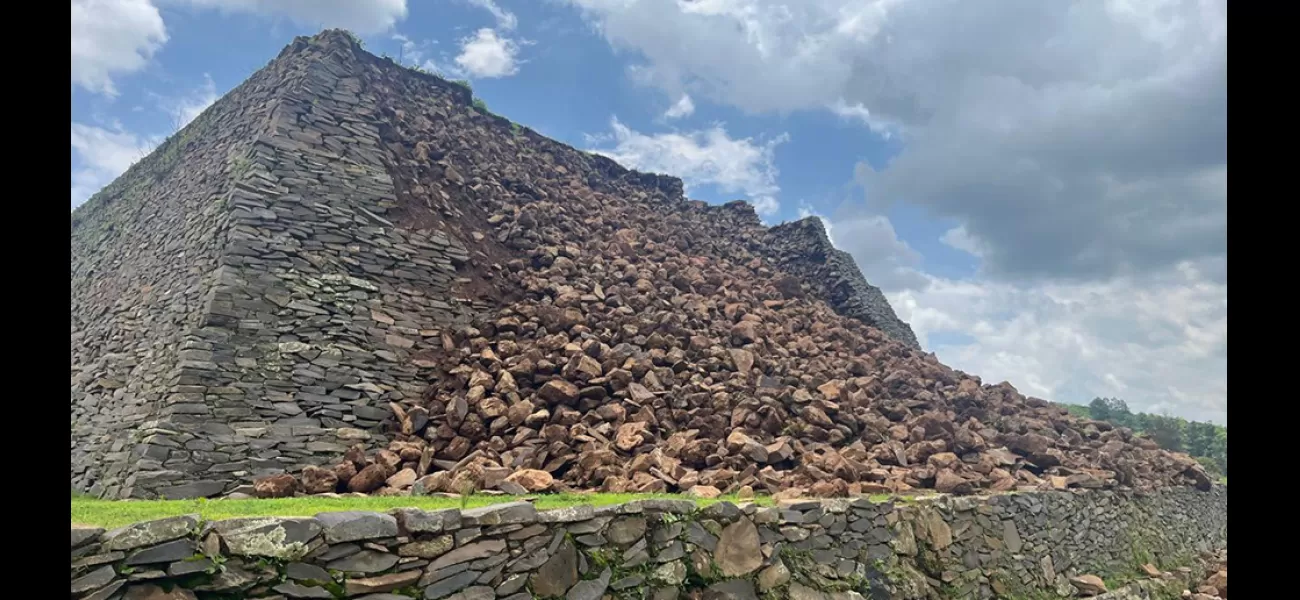An old pyramid in Mexico collapses unexpectedly, causing concern about a potential bad omen.
What level of belief do you have in superstitions?
August 19th 2024.

The crumbling of an ancient pyramid in Mexico has caused quite a stir among archaeologists and locals alike. The majestic structure, located in the Ihuatzio Archaeological Zone near Lake Pátzcuaro in the state of Michoacán, collapsed under the weight of heavy rains. It was a shocking sight, as the pyramid had stood strong for centuries. Some even believe that this unexpected event could be a sign of something ominous approaching.
According to experts, the pyramid's south wall gave way due to the intense pressure of the heavy rainfall. The high temperatures in the region had already caused cracks in the structure, making it vulnerable to the water seeping into its stones. As a result, the central part of the south wall crumbled into a pile of rubble.
Researchers from Mexico's National Institute of Anthropology and History (INAH) have been studying the effects of global climate change on ancient sites. They confirmed that the heavy rains on the night of July 29th, 2024 were the primary cause of the pyramid's collapse. The combination of extreme temperatures and drought had weakened the structure, making it unable to withstand the downpour.
The INAH quickly dispatched a team to assess the damage and come up with a plan to repair the pyramid. Upon arrival, they discovered that not only the exterior wall was damaged, but also the core and retaining wall. The collapse of the pyramid was a severe blow, as previous attempts to repair other damaged buildings and artifacts had proven unsuccessful. However, the experts were determined to use different techniques to rebuild this important piece of history.
The pyramid was thought to have been constructed around 1,100 years ago by the ancestors of the modern Purépecha people. This indigenous community in Michoacán takes great pride in their heritage and considers the pyramid a sacred space. It is believed that it served as a site for spiritual rituals and ceremonies, and possibly even held some political significance.
The Purépecha empire was a powerful force in the region, rivaling even the mighty Aztec empire. Many battles were fought between the two, but the Purépechans were one of the few indigenous groups that could not be conquered by the Aztecs. Today, their descendants still reside in the northwestern region of Michoacán, and the collapse of the pyramid was seen as a bad omen by one Purépechan who posted on Facebook: "Before the arrival of the conquerors, something similar happened to the purhé worldview. This collapse could be a sign that the Gods are displeased."
Unfortunately, the pyramid was not the only structure to succumb to the effects of climate change. Just days later, another popular tourist spot, the Double Arch in Utah's Glen Canyon National Recreation Area, also collapsed. This stunning rock feature, which had stood for millions of years, was formed from 190 million year old Navajo sandstone. However, the changing shoreline of Lake Powell, caused by prolonged drought and climate change, may have played a role in its collapse.
The collapse of the ancient pyramid and the Double Arch serve as a reminder of the devastating effects of climate change on our planet. It is a wake-up call to take action and protect our precious historical sites for future generations. The INAH is determined to not only restore the pyramid but also to thoroughly repair its structure. The collapse may have been a tragic event, but it has shed light on the importance of preserving our past for the future.
According to experts, the pyramid's south wall gave way due to the intense pressure of the heavy rainfall. The high temperatures in the region had already caused cracks in the structure, making it vulnerable to the water seeping into its stones. As a result, the central part of the south wall crumbled into a pile of rubble.
Researchers from Mexico's National Institute of Anthropology and History (INAH) have been studying the effects of global climate change on ancient sites. They confirmed that the heavy rains on the night of July 29th, 2024 were the primary cause of the pyramid's collapse. The combination of extreme temperatures and drought had weakened the structure, making it unable to withstand the downpour.
The INAH quickly dispatched a team to assess the damage and come up with a plan to repair the pyramid. Upon arrival, they discovered that not only the exterior wall was damaged, but also the core and retaining wall. The collapse of the pyramid was a severe blow, as previous attempts to repair other damaged buildings and artifacts had proven unsuccessful. However, the experts were determined to use different techniques to rebuild this important piece of history.
The pyramid was thought to have been constructed around 1,100 years ago by the ancestors of the modern Purépecha people. This indigenous community in Michoacán takes great pride in their heritage and considers the pyramid a sacred space. It is believed that it served as a site for spiritual rituals and ceremonies, and possibly even held some political significance.
The Purépecha empire was a powerful force in the region, rivaling even the mighty Aztec empire. Many battles were fought between the two, but the Purépechans were one of the few indigenous groups that could not be conquered by the Aztecs. Today, their descendants still reside in the northwestern region of Michoacán, and the collapse of the pyramid was seen as a bad omen by one Purépechan who posted on Facebook: "Before the arrival of the conquerors, something similar happened to the purhé worldview. This collapse could be a sign that the Gods are displeased."
Unfortunately, the pyramid was not the only structure to succumb to the effects of climate change. Just days later, another popular tourist spot, the Double Arch in Utah's Glen Canyon National Recreation Area, also collapsed. This stunning rock feature, which had stood for millions of years, was formed from 190 million year old Navajo sandstone. However, the changing shoreline of Lake Powell, caused by prolonged drought and climate change, may have played a role in its collapse.
The collapse of the ancient pyramid and the Double Arch serve as a reminder of the devastating effects of climate change on our planet. It is a wake-up call to take action and protect our precious historical sites for future generations. The INAH is determined to not only restore the pyramid but also to thoroughly repair its structure. The collapse may have been a tragic event, but it has shed light on the importance of preserving our past for the future.
[This article has been trending online recently and has been generated with AI. Your feed is customized.]
[Generative AI is experimental.]
0
0
Submit Comment





